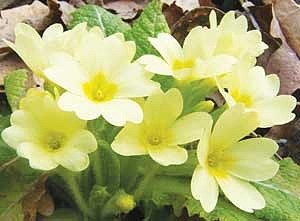
Garden News
Early spring is probably one of my favourite times of the gardening year, there is a slight glimpse of what is to come as early flowering bulbs and perennials open their bright and, often, fragrant flowers towards the sun. The sweet smell of spring hangs in the air and we can leave the winter behind us.Plant of The Month – Primula Vulgaris.
Primula vulgaris could be considered to be evergreen but occasionally it will retreat and become dormant in the summer during hot, dry weather. The Primrose is one of our most familiar and attractive native wild flowers. This low carpeting perennial has pale yellow flowers with a deep yellow centre, which are in bloom from March to May.
Primulas have two different types of flowers which look superficially almost identical. One type is called ‘pin-eyed’ and the other, ‘thrum-eyed’. The two different types of flowers are produced on separate plants. The production of two different types of flowers is an adaptation to promote cross pollination. In pin-eyed flowers, the stigma is at the top of the flower tube and can be seen in the centre of the flower looking like a small green pin head. In the thrum-eyed type, the style reaches only halfway up the flower tube, so that the stigma is also positioned halfway up inside the tube. The anthers in this type are located at the top of the flower tube and can be seen as an orange ring in the centre of the flower.
Primulas are plants for cool, often shaded locations. They are found growing in the wild at the edge of woodlands, in hedgerows, on north facing banks and mountain and coastal cliffs. While Primulas prefer a bit of moisture, most don’t like to be waterlogged. They do, however, thrive on most soil types making it the ideal plant for any garden.
During the course of history, various parts of the primrose have been used in herbal medicine; the root was used as a reliable and safe emetic (it induces vomiting) and as an antispasmodic. The whole plant was thought to be a sedative, the leaves were used to treat wounds and primrose tea was believed to relieve nervous disorders. There is some confusion over the origin of the name 'Primrose', however it is now widely accepted that it is a corruption of the Italian 'primaverola', which in turn is a diminutive of 'fior di prima vera' meaning the first flower of Spring. The Cowslip and Oxlip owe their names to the most unseemly words 'cow slop' and 'ox slop'.
Primulas often look best when naturalised, in a wilder location. A lot of us don’t have the room to recreate this sort of scheme in our own gardens, so we overlook the possibilities of awhat can still be achieved within our small urban plots. If you don’t have space to litter a meadow with thousands of primula plugs then think about dotting them throughout your border, under deciduous shrubs, in between your spreading perennials where they will recreate the naturalised look within your more formal setting, providing a striking start to the beginning of the year.
There’s nothing vulgar about primula vulgaris, so make the most of it, whether that be in your garden or in the wild.
Jobs to be done in January:
Ornamental Garden:
• A general fertiliser could be applied over borders if felt necessary. If leaves look yellow on shrubs then give them a folate feed (liquid feed via watering can).
• Aerate lawn with a wire rake if mild and not waterlogged.
• Remove any dead, diseased or damaged growth from trees and shrubs.
• Finish mulching if not done in Autumn.
• Put manure/rose feed around all roses and check for dead, diseased or dying shoots.
• Deadhead bulbs regularly.
• Now is a good time to plant new Perennials and summer-flowering bulbs.Re-pot/top-dress all containers.
• Weed regularly.
• Edge/define all borders if not done already.
• Plant Roses.
• Sow hardy annuals for summer colour.
• Repair damage to lawns if necessary.
• Harden off hardy annuals sown under glass.
• Cut back any remaining growth from herbaceous/grasses left over from the winter.
• Divide summer flowering perennials like astrantia, hemorocallis, hosta etc.
• Coppice dogwoods/willows etc if not done before now.
Vegetable Garden:
• Prune Gooseberries and red and white currants. Remove deadwood and then spur prune all sideshoots back to 2–3 buds from the base. Shorten branch tips by 1/4.
• Direct sow shallots and onion setts.
• Harvest the last of the winter crops and compost any un-diseased debris.
• Sow aubergines, cucumbers, tomatoes and chillies in an indoor heated propagator.

